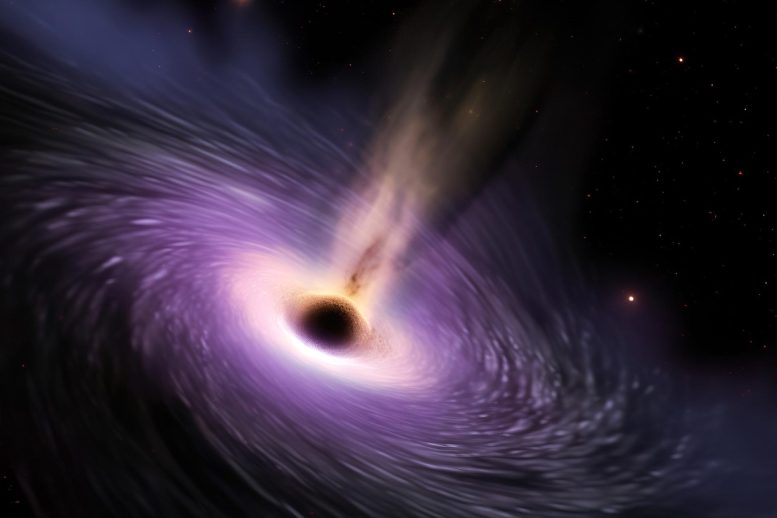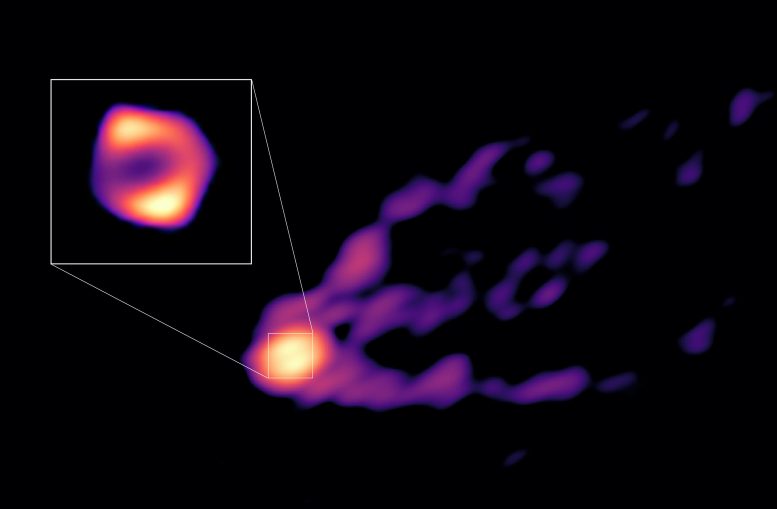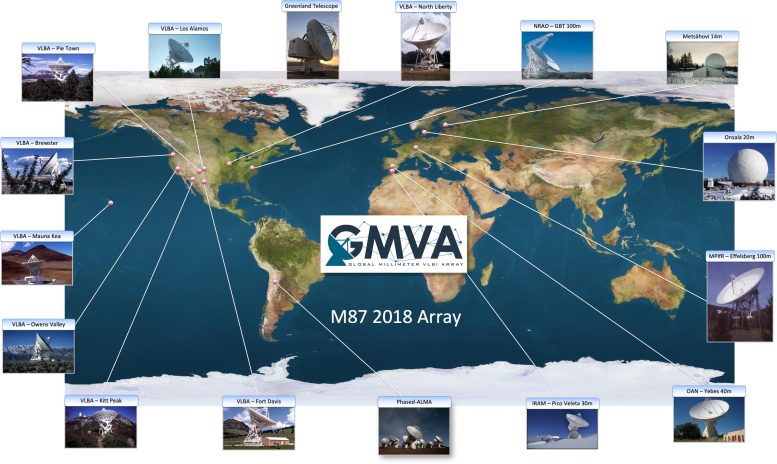
Scientists used new technology to produce an unprecedented image of both the accretion process and the jet of the Messier 87 black hole. Utilizing the GMVA, ALMA, and GLT, they’ve observed a larger ring-like structure and a broader radiation from the inner region of the black hole, implying the existence of an outblowing wind. This breakthrough reveals previously unseen details about black holes.
An international team of scientists led by Dr. Rusen Lu from the Shanghai Astronomical Observatory (SHAO) of the Chinese Academy of Sciences has used new millimeter-wavelength observations to produce an image that shows, for the first time, both the ring-like accretion structure around a black hole, where matter falls into the black hole, and the black hole’s associated powerful relativistic jet. The source of the images was the central black hole of the prominent radio galaxy Messier 87.
The study was recently published in the journal Nature.
The image underlines for the first time the connection between the accretion flow near the central supermassive black hole and the origin of the jet. The new observations were obtained with the Global Millimeter VLBI Array (GMVA), complemented by the phased Atacama Large Millimeter/submillimeter Array (ALMA) and the Greenland Telescope (GLT). The addition of these two observatories has greatly enhanced the imaging capabilities of the GMVA.

“Previously, we had seen both the black hole and the jet in separate images, but now we have taken a panoramic picture of the black hole together with its jet at a new wavelength,” said Dr. Lu.
A New Perspective with Advanced Observations
The surrounding material is thought to fall into the black hole in a process known as accretion. But no one had ever imaged it directly.
According to Lu, the ring that was seen before was becoming larger and thicker at the 3.5 mm observing wavelength. “This shows that the material falling into the black hole produces additional emission that is now observed in the new image. This gives us a more complete view of the physical processes acting near the black hole,” said Lu.
The participation of ALMA and GLT in the GMVA observations and the resulting increase in resolution and sensitivity of this intercontinental network of telescopes has made it possible to image the ring-like structure in M87 for the first time at the 3.5 mm wavelength. The diameter of the ring measured by the GMVA is 64 microarcseconds, which corresponds to the size of a small (5-inch/13-cm) selfie ring light on Earth as seen by an astronaut on the Moon. This diameter is 50 percent larger than what was seen in observations by the Event Horizon Telescope at 1.3 mm, in accordance with expectations for the emission from relativistic plasma in this region.

“With the greatly improved imaging capabilities by adding ALMA and GLT into GMVA observations, we have gained a new perspective. We do indeed see the triple-ridged jet that we knew about from earlier VLBI observations,” said Thomas Krichbaum of the Max Planck Institute for Radio Astronomy (MPIfR) in Bonn. “But now we can see how the jet emerges from the emission ring around the central supermassive black hole and we can measure the ring diameter also at another (longer) wavelength.”
A Black Hole That’s Surprisingly Not So Hungry
The light from M87 is produced by the interplay between highly energetic electrons and magnetic fields, a phenomenon called synchrotron radiation. The new observations, at a wavelength of 3.5 mm, reveal more details about the location and energy of these electrons. They also tell us something about the nature of the black hole itself: It is not very hungry. It consumes matter at a low rate, converting only a small fraction of it into radiation.
According to Keiichi Asada from the Institute of Astronomy and Astrophysics of Academia Sinica, “To understand the physical origin of the bigger and thicker ring, we had to use computer simulations to test different scenarios. As a result, we concluded that the larger extent of the ring is associated with the accretion flow.”
Kazuhiro Hada from the National Astronomical Observatory of Japan noted that the team also found something “surprising” in their data. “The radiation from the inner region close to the black hole is broader than we expected. This could mean that there is more than just gas falling in. There could also be a wind blowing out, causing turbulence and chaos around the black hole,” said Hada.
The quest to learn more about Messier 87 is not over, as further observations and a fleet of powerful telescopes continue to unlock its secrets. “Future observations at millimeter wavelengths will study the time evolution of the M87 black hole and provide a polychromatic view of the black hole with multiple color images in radio light,” said Jongho Park of the Korea Astronomy and Space Science Institute.
For more on this discovery:
- Historic First Direct Image of a Black Hole Emitting a Powerful Jet
- New Black Hole Images Reveal a Glowing, Fluffy Ring and High-Speed Jet
- Black Hole and Powerful Jet Unveiled in Exquisite Detail
- Unprecedented Image of Black Hole’s Powerful Jet and Shadow
Reference: “A ring-like accretion structure in M87 connecting its black hole and jet” by Ru-Sen Lu, Keiichi Asada, Thomas P. Krichbaum, Jongho Park, Fumie Tazaki, Hung-Yi Pu, Masanori Nakamura, Andrei Lobanov, Kazuhiro Hada, Kazunori Akiyama, Jae-Young Kim, Ivan Marti-Vidal, José L. Gómez, Tomohisa Kawashima, Feng Yuan, Eduardo Ros, Walter Alef, Silke Britzen, Michael Bremer, Avery E. Broderick, Akihiro Doi, Gabriele Giovannini, Marcello Giroletti, Paul T. P. Ho, Mareki Honma, David H. Hughes, Makoto Inoue, Wu Jiang, Motoki Kino, Shoko Koyama, Michael Lindqvist, Jun Liu, Alan P. Marscher, Satoki Matsushita, Hiroshi Nagai, Helge Rottmann, Tuomas Savolainen, Karl-Friedrich Schuster, Zhi-Qiang Shen, Pablo de Vicente, R. Craig Walker, Hai Yang, J. Anton Zensus, Juan Carlos Algaba, Alexander Allardi, Uwe Bach, Ryan Berthold, Dan Bintley, Do-Young Byun, Carolina Casadio, Shu-Hao Chang, Chih-Cheng Chang, Song-Chu Chang, Chung-Chen Chen, Ming-Tang Chen, Ryan Chilson, Tim C. Chuter, John Conway, Geoffrey B. Crew, Jessica T. Dempsey, Sven Dornbusch, Aaron Faber, Per Friberg, Javier González García, Miguel Gómez Garrido, Chih-Chiang Han, Kuo-Chang Han, Yutaka Hasegawa, Ruben Herrero-Illana, Yau-De Huang, Chih-Wei L. Huang, Violette Impellizzeri, Homin Jiang, Hao Jinchi, Taehyun Jung, Juha Kallunki, Petri Kirves, Kimihiro Kimura, Jun Yi Koay, Patrick M. Koch, Carsten Kramer, Alex Kraus, Derek Kubo, Cheng-Yu Kuo, Chao-Te Li, Lupin Chun-Che Lin, Ching-Tang Liu, Kuan-Yu Liu, Wen-Ping Lo, Li-Ming Lu, Nicholas MacDonald, Pierre Martin-Cocher, Hugo Messias, Zheng Meyer-Zhao, Anthony Minter, Dhanya G. Nair, Hiroaki Nishioka, Timothy J. Norton, George Nystrom, Hideo Ogawa, Peter Oshiro, Nimesh A. Patel, Ue-Li Pen, Yurii Pidopryhora, Nicolas Pradel, Philippe A. Raffin, Ramprasad Rao, Ignacio Ruiz, Salvador Sanchez, Paul Shaw, William Snow, T. K. Sridharan, Ranjani Srinivasan, Belén Tercero, Pablo Torne, Efthalia Traianou, Jan Wagner, Craig Walther, Ta-Shun Wei, Jun Yang and Chen-Yu Yu, 26 April 2023, Nature.
DOI: 10.1038/s41586-023-05843-w
Never miss a breakthrough: Join the SciTechDaily newsletter.
Follow us on Google, Discover, and News.
13 Comments
A couple of things about this article. The M87 Black Hole is “not very hungry”. I had assumed that Black Holes gobble everything nearby, with no qualitative measure of “hungriness”. Also, they speculate that gas is falling in and a wind is blowing out. How can a wind blow out? BTW, they don’t specifically say their data (from the direction of light from the gas) actually shows the gas falling in.
Perhaps something very different is happening. Go to YouTube to see “Active Galaxies – A String Theory Way”.
String theory is a math theory, but the actual physics of the black hole driven outflow wind – a favored model for how quasars regulate galaxy star formation by blowing gas away – is described in the paper.
“The observed parabolic shape is consistent with a black-hole-driven jet through the Blandford–Znajek process. … In addition to the jet, high-mass loaded, gravitationally unbound and non-relativistic winds have been found in RIAF simulations. They are driven by the combination of centrifugal force and gas and magnetic pressure and are considered as an essential component collimating the Blandford–Znajek jet into a parabolic shape. Non-thermal electrons accelerated by physical processes such as magnetic reconnection and shocks presumably exist in the wind. The synchrotron radiation of these non-thermal electrons may be responsible for this extra emission component outside the Blandford–Znajek jet.” [References removed for readability.]
“Expand to show full article” == annoying popup
So, armed with this galaxy shattering data, how many starving asian children would the billions wasted on this project feed and clothe?
None. Because most people know, except those like you, that if you feed thousands of starving children, they create millions more starving children, continuing the cycle of disease and poverty. Highly functioning societies are not created from hand outs. Try spending more time outdoors. Then you might learn to see the forest from the trees.
This science did not waste money – it gave results – nor did it cost “billions” of something or other.
Nor do we see much starvation globally, especially not in Asia, and it is definitely not science causing any of it. “More than 48 million people are facing emergency levels of hunger, with the threat of acute malnutrition, starvation, and death, according to the World Food Programme (WFP). … Conflict, extreme weather patterns, and disparities caused by economic shocks and health crises, including the coronavirus pandemic, are main drivers…”. [World Vision] 48 million out of a global population of 8 billion means a starvation level of 0.006 percent.
It is hard to say other influences of science on specific cases. But it is easy to tell that science is among the best return on investments work we have and that it is mutually reinforcing. Not doing astronomy would likely mean more starvation.
Have u ever thought it might be a photon star with two event horizon’s but yes u did jet part right
The caption on the image at top of the article is heavily misleading without the clarification that the first image is an artist’s rendering.
It’s all fake. What they get is a blob of infrared heat billions of years old of any object that WAS there billions of years ago. What they have to show the preyed upon taxpayers is a Polaroid snapshot of yesterday afternoon.
Wow, some brainlets in the comments section. This work is more important than Asia and isn’t fake you mongoloids.
Taxpayers are, in democracies, willingly paying taxes since they get benefits not otherwise provided. Paying too much taxes is another topic, but that has nothing to do with valuables such as science. Which for instance gave you the web which you comment on…
I’m shocked at the crude confrontational displayed here…where is the moderator?
Wherever this leads to, however humanity needs answers, concrete and meaningful. Thumbs up for all the reasarch crew.